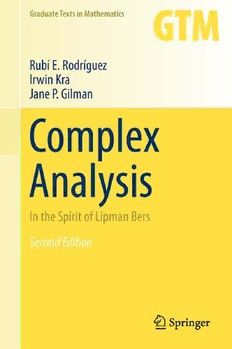Table Of ContentGraduate Texts in Mathematics 245
Graduate Texts in Mathematics
SeriesEditors:
SheldonAxler
SanFranciscoStateUniversity,SanFrancisco,CA,USA
KennethRibet
UniversityofCalifornia,Berkeley,CA,USA
AdvisoryBoard:
ColinAdams,WilliamsCollege,Williamstown,MA,USA
AlejandroAdem,UniversityofBritishColumbia,Vancouver,BC,Canada
RuthCharney,BrandeisUniversity,Waltham,MA,USA
IreneM.Gamba,TheUniversityofTexasatAustin,Austin,TX,USA
RogerE.Howe,YaleUniversity,NewHaven,CT,USA
DavidJerison,MassachusettsInstituteofTechnology,Cambridge,MA,USA
JeffreyC.Lagarias,UniversityofMichigan,AnnArbor,MI,USA
JillPipher,BrownUniversity,Providence,RI,USA
FadilSantosa,UniversityofMinnesota,Minneapolis,MN,USA
AmieWilkinson,UniversityofChicago,Chicago,IL,USA
GraduateTextsinMathematicsbridgethegapbetweenpassivestudyand
creativeunderstanding,offeringgraduate-levelintroductionstoadvancedtopicsin
mathematics.Thevolumesarecarefullywrittenasteachingaidsandhighlight
characteristicfeaturesofthetheory.Althoughthesebooksarefrequentlyusedas
textbooksingraduatecourses,theyarealsosuitableforindividualstudy.
Forfurthervolumes:
http://www.springer.com/series/136
Rub´ı E. Rodr´ıguez (cid:129) Irwin Kra (cid:129) Jane P. Gilman
Complex Analysis
In the Spirit of Lipman Bers
Second Edition
123
Rub´ıE.Rodr´ıguez IrwinKra
FacultaddeMatema´ticas DepartmentofMathematics
PontificiaUniversidadCato´licadeChile StateUniversityofNewYorkatStonyBrook
Santiago,Chile StonyBrook,NY,USA
JaneP.Gilman
DepartmentofMathematics
andComputerScience
RutgersUniversity
Newark,NJ,USA
ISSN0072-5285
ISBN978-1-4419-7322-1 ISBN978-1-4419-7323-8(eBook)
DOI10.1007/978-1-4419-7323-8
SpringerNewYorkHeidelbergDordrechtLondon
LibraryofCongressControlNumber:2012950351
©SpringerScience+BusinessMediaNewYork2007,2013
Thisworkissubjecttocopyright.AllrightsarereservedbythePublisher,whetherthewholeorpartof
thematerialisconcerned,specificallytherightsoftranslation,reprinting,reuseofillustrations,recitation,
broadcasting,reproductiononmicrofilmsorinanyotherphysicalway,andtransmissionorinformation
storageandretrieval,electronicadaptation,computersoftware,orbysimilarordissimilarmethodology
nowknownorhereafterdeveloped.Exemptedfromthislegalreservationarebriefexcerptsinconnection
with reviews or scholarly analysis or material supplied specifically for the purpose of being entered
and executed on a computer system, for exclusive use by the purchaser of the work. Duplication of
this publication or parts thereof is permitted only under the provisions of the Copyright Law of the
Publisher’slocation,initscurrentversion,andpermissionforusemustalwaysbeobtainedfromSpringer.
PermissionsforusemaybeobtainedthroughRightsLinkattheCopyrightClearanceCenter.Violations
areliabletoprosecutionundertherespectiveCopyrightLaw.
Theuseofgeneraldescriptivenames,registerednames,trademarks,servicemarks,etc.inthispublication
doesnotimply,evenintheabsenceofaspecificstatement,thatsuchnamesareexemptfromtherelevant
protectivelawsandregulationsandthereforefreeforgeneraluse.
While the advice and information in this book are believed to be true and accurate at the date of
publication,neithertheauthorsnortheeditorsnorthepublishercanacceptanylegalresponsibilityfor
anyerrorsoromissionsthatmaybemade.Thepublishermakesnowarranty,expressorimplied,with
respecttothematerialcontainedherein.
Printedonacid-freepaper
SpringerispartofSpringerScience+BusinessMedia(www.springer.com)
ForVictor,EleanorandBob
andtothememoryof
Maryand LipmanBers
Preface to Second Edition
The second edition contains significant new material in several new sections. We
have also expanded sections from the first edition (improving, we expect, the
exposition throughout) and included new figures and exercises for added clarity,
aswellas,ofcourse,correctederrorsandtyposinthepreviousversion.
Amongthemostimportantchangesare:
(cid:129) Wehaveexpandedandclarifiedseveralsectionsfromthefirstedition.
(cid:129) We have significantlyenlargedthe exercisesections. Someof the problemsare
routine,otherschallenging,andsomerequireknowledgeofothersubjectsusually
coveredin variousfirst-year graduate courses. The problemsare listed in more
orlessrandomorderasfarastheirdifficulty.
(cid:129) In both editions of this text, we use the approach to integration based on
differentialforms.Inanalternativeapproachdifferentialformsareaby-product
ofworkonintegrationoffunctionsmotivatedbyideasfromstandardtreatments
ofintegralcalculus.ThatistheapproachthatBerstookincoursesthathetaught;
itisalsotheapproachusedbyAhlfors.Ofcourse,eitherofthetwoapproaches
are equallyvalid and lead to the same major results. In this second edition,we
provideanappendixthatoutlinesthisalternativepathtothemainresults.
(cid:129) New sections on Perron’s method for solving the Dirichlet problem, Green’s
function,analternativeproofoftheRiemannmappingtheorem,andadescription
of the divisor of a bounded analytic function on the disc via infinite Blaschke
productsareincluded.
(cid:129) We prove the Bers theorem on isomorphisms between rings of holomorphic
functionsonplanedomains.
(cid:129) AsectiononhistoricalreferencespreparedbyRanjanRoyhasbeenadded.
Inaddition,thefollowingitemsrelatedtoourworkmightbeofinteresttothose
readingthisvolume.
(cid:129) An answer manual for the exercises prepared by Vamsi Pritham Pingali is
available,toinstructorsusingthebookforacourse,fromthepublisher.
(cid:129) Anelectronicversionofthebookisavailablefromthepublisher.
vii
viii PrefacetoSecondEdition
(cid:129) One of the authors(IK) has created and maintainsa section aboutthe book on
hiswebsite.Itcontains,amongotherthings,updatedinformationanderrata.
http://www.math.sunysb.edu/(cid:2)irwin/bookcxinfo.html
Theotherauthorsmayalsohaveinformationaboutthebookontheirwebsites.
ItisourpleasuretothankRanjanRoyforproducingandallowingustoincludein
thisvolumehishistoricalnote.Wearegratefultoourcolleaguesandstudentswho
pointedoutplacesfor improvementin the first edition and in drafts of the second
one. Among them: Bill Abikoff, Robert Burckel, Eduardo Friedman, Bryna Kra,
Peter Landweber, Howard Masur, Sudeb Mitra, Lee Mosher, Robert Sczech, and
JacobSturm.Itisstilltrue,ofcourse,thaterrorsandshortcomingsmayremainin
thefinalversionofthiseditionandtheseareentirelyourresponsibility.
Spring2012
NewYork,NY,USA IrwinKra
Santiago,Chile Rub´ıE.Rodr´ıguez
Newark,NJ,USA JaneP.Gilman
Preface to First Edition
This book presents fundamental material that should be part of the education of
everypracticingmathematician.This materialwill also be of interestto computer
scientists,physicistsandengineers.
Becausecomplexanalysishasbeenusedbygenerationsofpracticingmathemati-
ciansworkinginanumberofdifferentfields,thebasicresultshavebeendeveloped
and redeveloped from a number of different perspectives. We are not wedded to
any one viewpoint. Rather we will try to exploit the richness of the development
andexplainandinterpretstandarddefinitionsandresultsusingthemostconvenient
toolsfromanalysis, geometryand algebra.Complexanalysishasconnectionsand
applicationstomanyothersubjectsinmathematics,bothclassicalandmodern,and
toothersciences.Itisanareawheretheclassicalandthemoderntechniquesmeet
andbenefitfromeachother.Wewilltrytoillustratethisintheapplicationswegive.
Complexanalysisisthestudyofcomplexvaluedfunctionsofacomplexvariable
and its initial task is to extend the concept of differentiability from real valued
functions of a real variable to these functions. A complex valued function of a
complexvariable that is differentiableis termedanalytic, and the first part of this
book is a study of the many equivalent ways of understanding the concept of
analyticity.Theequivalentwaysofformulatingtheconceptofananalyticfunction
are summarized in what we term the fundamental theorem for functions of a
complexvariable. In dedicatingthe first part of this book to the very precise goal
of stating and proving the fundamentaltheorem we follow a path in the tradition
of Lipman Bers from whom we learned the subject. In the second part of the
text we then proceed to the leisurely exploration of interesting consequences and
applicationsofthefundamentaltheorem.
We are gratefulto LipmanBersforintroducingusto the beautyofthe subject.
ThebookisanoutgrowthofnotesfromBers’soriginallectures.Versionsofthese
notes have been used by us at our respective home institutions, some for more
than20years,aswellasbyothersatvariousuniversities.Wearegratefultomany
colleaguesand students who read and commentedon these notes. Our interaction
ix

